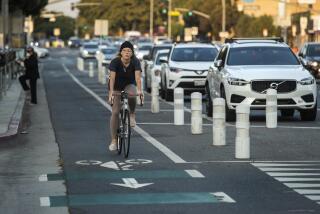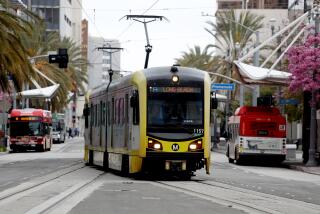Elevated Rail Likely to Require Freeway Work : Transportation: Report finds new and costly widening of the Ventura route would be necessary if monorail proposal wins out over subway.
- Share via
Building a proposed elevated rail line along the median of the Ventura Freeway may require further widening of the heavily used freeway and substantially increase construction time and the project’s $2.6-billion price tag, according to a report by county transportation officials.
The freeway, on which widening work is just being completed, may have to be widened again, which could include rebuilding bridges and moving sound walls in several locations between Universal City and Woodland Hills to make room for the rail line’s support columns, according to the report by staff of the Los Angeles County Transportation Commission.
The report was prepared for a commission panel that will meet Wednesday to decide which of two rival east-west rail line plans to support for the San Fernando Valley. The entire commission will meet on Dec. 16 to make a final decision on the line.
At issue is the design and route of a line that will connect Warner Center in Woodland Hills to the Metro Red Line, either in North Hollywood or Universal City. The alternative to the freeway line is a $3.03-billion rail line that would run mostly underground, paralleling Burbank and Chandler boulevards.
To build the freeway line, workers must install support columns four to six feet wide on the freeway median, which ranges in width from six to eight feet, according to the report prepared for the panel, the Planning and Mobility Improvement Committee. But the report said state and federal guidelines may require a wider setback between the columns and freeway traffic.
“This setback is less than the minimum called for in highway design standards and if it is determined by either Caltrans or the Federal Highway Administration to be unacceptable . . . widening of the freeway . . . would be the only way to provide additional room,” the report said.
The California Department of Transportation is currently completing a $40-million effort to widen and improve the Ventura Freeway. Completion of the project was expected more than a year ago but is being delayed by final drainage work and the re-striping of some lanes.
The freeway improvements were meant to help ease traffic congestion on one of the nation’s busiest thoroughfares. On a typical weekday on the Ventura Freeway, an average of 277,000 vehicles pass between the San Diego Freeway and Hayvenhurst Avenue.
An elevated freeway line would be about $403 million less expensive and could be built more quickly than the Burbank-Chandler alternative, according to county researchers. But if freeway widening were required, that “could offset any apparent savings in the construction costs of the Ventura Freeway alternative and require additional environmental review,” the report said.
David L. Mieger, the commission’s project manager for the Valley line, said the only way to determine for certain if freeway widening is needed is to complete detailed engineering studies of the project and submit them to state and federal authorities for review. Such studies would normally be done after the project is approved, he said.
Mieger said it is not clear yet how much widening would be needed and how much it would increase the cost of the project but the engineering studies needed to answer those questions would take up to two years to complete.
“So, there is a potential there for some delay and some additional costs,” he said.
Although supporters of the freeway line have lobbied for a high-speed, low-noise monorail line on the freeway median, the transportation commission has not ruled out the possibility of using other technology, such as light rail, for the line.
A spokeswoman for Supervisor Mike Antonovich, chairman of the transportation commission and a key supporter of the elevated freeway line proposal, minimized the significance of the study, saying further review of the freeway line has always been inevitable.
“Basically, it’s not a hurdle that cannot be jumped,” said Rosa Kortizija, Antonovich’s transportation deputy.
But Gerald A. Silver, president of Homeowners of Encino and head of a coalition of homeowner groups opposed to the elevated freeway line, said the study provides additional reasons why the line should not be built.
“This is the message we have said from day one: It’s not feasible,” he said.
Silver’s group, the Coalition of Freeway Residents, has argued that a freeway line will generate noise, traffic congestion and visual blight for residents along the freeway corridor.
Silver’s group was joined in opposing the freeway line by the Los Angeles City Community Redevelopment Agency and the city’s Planning Commission.
In a letter sent late last month to the transportation commission, the redevelopment agency said the Burbank-Chandler line would revitalize economically depressed areas in North Hollywood. The Planning Commission said in a letter dated Nov. 18 that it opposes the elevated freeway line because, among other reasons, it would lead to increased traffic congestion on the freeway from commuters using it to reach the rail system stops.
More to Read
Sign up for Essential California
The most important California stories and recommendations in your inbox every morning.
You may occasionally receive promotional content from the Los Angeles Times.











